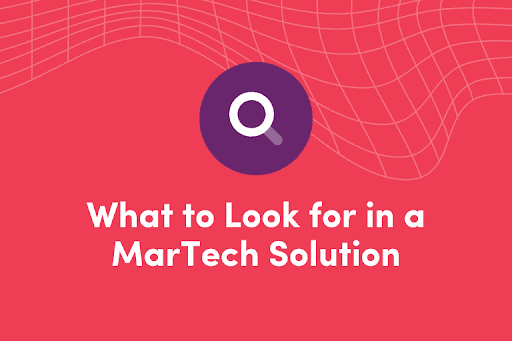It doesn’t take a genius to notice the obvious: the marketing landscape has exploded.
According to Chief Martec, the ecosystem has expanded by 100x since 2011, now including over 15,000 solutions. Enterprise brands now use an average of 120 different tools to power their customer experiences, so choosing the right platform among the sea of options has never been more critical.
In the new era of moments-based marketing, your martech stack shouldn’t simply keep pace with technological advancement—it should be at the forefront of it.
Here’s what to look for in a modern martech solution that delivers value today—and scales for tomorrow.
Why It’s Time to Rethink Your MarTech Stack
Legacy platforms were built for a bygone era, when marketing meant mass emails, basic segmentation, and static campaigns. But today’s tech-savvy consumers expect hyper-personalized experiences that feel seamless, not stitched together.
Nearly two-thirds (64%) of marketers we surveyed at Activate Summit 2025 reported sending the majority or entirety of their messages as batch-and-blast. Only 6% were mostly moments-based, with less than 30% batch sends.
It’s not that marketers want to be stuck in the past. Their outdated platforms are holding them back:
- Siloed or inaccessible data prevents a unified view of the customer
- Manual workflows and technical bottlenecks slow down execution
- Low engagement and high unsubscribe rates as a result of static sends
- Inability to respond in real time to customer behavior and intent
- A lack of tangible ROI from tech that overpromises and underdelivers
Modern marketing demands smarter, faster, and more scalable tools. It’s not just about ticking boxes off a feature checklist. It’s about activating real results and business outcomes.
5 Things to Look for When Evaluating MarTech Platforms
With so many tools and potential capabilities to choose from, selecting the right platform can feel paralyzing. How do you know what to prioritize?
Here are five factors that should be top of mind during your search:
1. Native Cross-Channel Orchestration: A True Cohesive Experience
- The Problem: Many legacy tools were designed for a single channel, whether that’s email, mobile, or social media. This siloed view leads to fragmented messaging and customer experiences that feel disjointed.
- Why It Matters: Customers don’t engage in silos. Brands that interact across three or more channels see a 287% increase in purchases, and omnichannel shoppers exhibit a 30% higher lifetime value. If you want more valuable customers, you need a centralized hub for cross-channel orchestration.
- What to Look For: Choose a platform that offers native support for all critical channels—email, SMS, mobile and web push, in-app messaging, WhatsApp, and more—within a single environment. Your solution should intelligently route messages to the right channel based on individual customer behavior and preferences, creating on seamless experience rather than six parallel ones.
| Iterable Resource: Download The Marketer’s Guide to Cross-Channel Success to deliver personalized experiences that meet your customers where they are. |
2. AI-Optimized Personalization and Automation—Not a Feature Add-On
“I believe that built-in AI is a strategic advantage in a martech platform…we’re transitioning to a built-in AI martech world, but many of the current offerings are bolt-on AI, packaged in various ways by marketing teams.”
– Jon Goodman, President at Range Digital
- The Problem: Too many martech providers have retrofitted AI onto legacy systems, essentially speeding up broken processes instead of rethinking them. Bolting on AI after the fact is not a transformation. It’s a patch.
- Why It Matters: AI isn’t just about saving time or increasing your efficiency gains. Brands using AI-driven personalization see up to a 20% increase in marketing ROI. But achieving this requires a deep integration of AI into your platform’s infrastructure. Your basic genAI plugins won’t get you there.
- What to Look For: Look for a platform built for AI from the start—with a flexible architecture that activates massive datasets and personalizes in real time. Seek out prescriptive, conversational, and goal-based AI that helps you dynamically adjust your engagement strategies based on live customer behavior—not after-the-fact reports.
|
Iterable Resource: Download our checklist on unlocking the power of AI to discover optimization opportunities that foster team efficiencies. Bonus: Iterable’s own AI agent Nova enables marketers to tap into generative and predictive AI to power more accurate and effective decision-making. |
3. Composability: A Platform That Adapts to Your Existing Tech Stack
“Future-ready stacks are flexible, well-integrated, and built on strong data foundations with embedded AI, open architecture, and clear roadmaps. Success also hinges on scalability, governance, and user adoption.”
– Adam Chandley, Head of Technology Strategy at Merkle
- The Problem: Siloed systems and clunky, legacy integrations make it nearly impossible for marketers to activate the customer data they already have. In fact, 70% of enterprise data goes unused, leading to an estimated $3.1 trillion in lost opportunity each year.
- Why It Matters: Your data is only as powerful as your ability to use it. If your martech platform can’t ingest and activate data from all sources—such as CRM, e-commerce, customer support, and analytics—you’re navigating without a map. And on top of that, you’re hemorrhaging money.
- What to Look For: Choose a platform with an open, composable architecture that allows you to plug into your existing stack—without heavy engineering. Look for marketer-first tools that let you move quickly and flexibly, using every data point to improve targeting and measurement.
| Iterable Resource: Download our guide with Hightouch that explains why the future of martech is composable and how to build an agile, data-driven stack. |
4. Unparalleled Scalability With Predictable Costs
- The Problem: Many software vendors lure teams in with low upfront costs, only to introduce unforeseen data overage fees or maintenance costs that snowball over time. This lack of transparency derails even the most promising martech investments.
- Why It Matters: Your platform should grow with you—without surprise bills. Inflexible tech stacks often result in 25-40% higher total costs as data volume and complexity scale. You need a solution that can grow with your business and offers transparent cost structures to ensure long-term ROI.
- What to Look For: Opt for a cloud-native solution with pricing that’s easy to predict and scale. Avoid platforms that nickel-and-dime you for data ingestion, extensions, or advanced segmentation logic. Your costs should be tied to business value—not arbitrary compute limits.
| Iterable Resource: Check out our RFP Template that makes the process of selecting your next customer engagement platform easier and more efficient. |
5. Best-in-Class Customer Support and Community
“Predictive analytics and generative AI are delivering measurable value in customer insights and scalable content creation, while agentic AI is freeing up human resources by handling complex tasks. However, many clients struggle to realise value due to gaps in strategy, talent, and data readiness.”
– Adam Chandley, Head of Technology Strategy at Merkle
- The Problem: Even the most advanced tools can fall flat without the right people and support behind them. Technical skill gaps and resource constraints mean that marketers often need help bridging the gap between vision and execution.
- Why It Matters: 74% of companies still struggle to scale the value of their AI investments, and much of that loss is due to a lack of education and support. In fact, 67% of marketers cite insufficient training as the top barrier to AI success. It’s not enough to spend money on new tools if you’re not going to invest in the right resources, whether it’s quality customer support, robust onboarding, or ongoing professional services.
- What to Look For: Seek a platform that acts as a partner, not just a vendor—with onboarding guidance and hands-on customer support that is aligned with your objectives. The best solutions have thriving communities and offer workshops and product showcases to keep your team ahead of the curve.
|
Iterable Resource: We don’t believe in gate-keeping our community, so everyone is welcome to gain valuable insights and collaborate with industry peers in the Iterable Plaza. Come join us and start making connections! |
FAQs About Migrating to a Modern MarTech Stack
1. Why should I replace my current marketing automation platform?
If your existing tools are keeping you stuck in batch-and-blast mode with manual workflows, limited personalization, or siloed data, it’s time to make the shift to moments-based marketing. A modern martech solution can greatly enhance your brand’s agility, engagement, and ROI.
“The singular biggest challenge we see is underutilization of tools or redundancies across their entire Martech stack. Lack of utilization can be a symptom of something larger at play, including data access or lack of data integration that is needed.”
– Maile Kaulukukui, Director of Technical Solutions and Services at Shaw/Scott
2. What are the signs that my martech stack is outdated?
The top signs that marketers have reported, according to our survey data, include fragmented or inconsistent data, which results in a lack of real-time personalization. This inability to personalize at scale ultimately leads to low engagement rates and negative brand sentiment.
“Clients also often underutilize their martech stack by focusing on producing more communication rather than analyzing and activating customer data to create great communication that actually delivers value.”
– Mårten Tilosius, Co-Founder and CEO of Miltton
It’s critical to upgrade your martech stack before your business is outpaced by brands that have the tools to activate data in seconds—not hours or days.
“Features that drive efficiency while creating business value, especially those that handle large data volumes to automate highly granular, on-brand personalized offers, are strong indicators of future-ready martech.”
– Mårten Tilosius, Co-Founder and CEO of Miltton
3. What’s the ROI of switching to a modern martech platform?
AI-powered modern martech platforms can drive 4x more revenue and 18x greater profits, according to Forrester Research.
“A marketer’s ROI for deploying new martech may look like faster-to-market campaign deployment with less lift on teams and an increase in percentage of utilized capabilities in the platform, but it could also be measured by higher deliverability and increased engagement across campaigns.
ROI on martech can also look like better attribution for omnichannel. An over-reliance on last-touch attribution, despite standing up multi-channel journeys, is something we see a lot. While easier to set parameters to, this tunnel-vision view of attribution really limits the marketer from truly understanding what opportunities there are to act on with those raised hand moments.”
– Maile Kaulukukui, Director of Technical Solutions and Services at Shaw/Scott
To calculate the value a platform like Iterable can bring to your brand, try out the Iterable Value Calculator, which provides a customized business case based on real results from 1,000+ Iterable customers.
4. What happens to my existing martech tools? Do I need to rip and replace them?
No, a best-in-breed martech should adapt to and enhance your current tech stack. Look for composable solutions that integrate with your existing platforms rather than all-in-one marketing clouds that keep your customer data siloed and inaccessible.
“Robust, scalable, and comprehensive open REST APIs is the basis of a good tool and the vast majority (~80%) of martech platforms do not have sufficiently good APIs or interconnectivity––either because they can’t interact with core pieces of the platform or they do not have the speed and rate limits necessary to operate in a modern high-scale environment.”
– Steven Aldrich, SVP, Marketing Services at Apply Digital
5. Can non-technical marketers use AI-driven platforms?
Absolutely. The best martech solutions are both built for marketers and loved by engineers. They remove bottlenecks by making the most complex decisions easy to execute for any marketing team.
“Built-in AI is considered table stakes in today’s requirements, allowing marketers to go from 0 to 1 very quickly. Few companies have their own models that are ready for production therefore a built-in model allows organisations to leverage AI in a way that allows them to activate it.”
– Julien De Visscher, Managing Director at Human37
Make sure to adopt platforms that offer intuitive and conversational interfaces, drag-and-drop journey builders, and prescriptive, AI-powered guidance.
The Iterable Difference
Iterable was purpose-built for the modern marketer, from its cross-channel orchestration and AI-native infrastructure to its composable design and world-class support.
Here’s what sets Iterable apart:


See Iterable in Action
Wondering if Iterable is the right fit for your business? If you want to modernize your martech, boost customer lifetime value, and scale efficiency → try our Value Calculator to quantify the impact of making the switch to Iterable, based on real ROI from 1,000+ customers.
Or, to see how Iterable’s modern martech platform can help your team build better customer experiences—get in touch today for a demo.

































